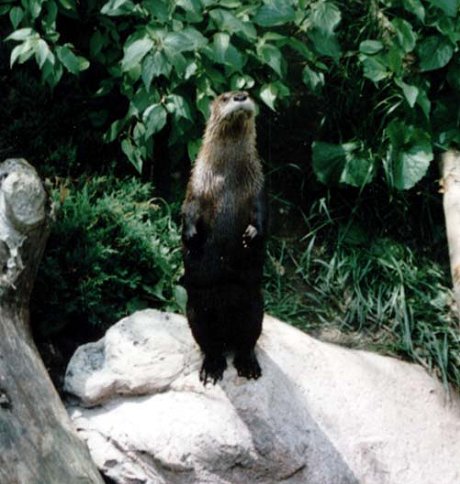IUCN/SSC Otter Specialist Group Bulletin

|
©IUCN/SCC Otter Specialist Group Volume 28 Issue 1 Pages 1- 60 (January 2011) Citation: Belanger, M., Clough, N., Askin, N., Tan, L. and Wittnich, C. (2011). A Review of Violent or Fatal Otter Attacks. IUCN Otter Spec. Group Bull. 28 (1): 11 - 16 A Review of Violent or Fatal Otter Attacks Michael Belanger1, Nicole Clough, Nesime Askin, Luke Tan and Carin Wittnich
1Oceanographic Environmental Research Society, 12 Burton Ave.,
Barrie, Ontario, Canada L4N 2R2. e-mail: michael.belanger@utoronto.ca |




 |
| Abstract: In general, the public view of otters is often described as playful, curious and that they are not known for aggressive towards humans. As well, otter attacks seem to be under reported both in the anecdotal reports or scientific publications. In light of recent otter attacks in Florida, we reviewed all evidence of otter attacks on humans for any geographical and temporal relationships from the earliest (1875) to the most recent (Dec 2010). There was a total 39 anecdotal articles and 4 scientific publications found dealing with violent human-otter interaction (bites, attacks, deaths). The majority of attacks dealt with the North American otter (Lontra canadensis - 77%) and geographically occurred most often in Florida (38%). The greatest number of attacks occurred from 1990 to 2009 (51%). Within the 39 documented anecdotal reports of otter attacks, rabies was confirmed in 24 to 66% of the cases. Otters are known to be very territorial in nature and in North America, have had increases in population numbers. In certain areas where otters occur naturally (Florida), there has been a huge surge of human expansion, which has encroached upon the otter’s natural habitat. This encroachment into the otter’s habitat may be one reason for the recent increases of otter attacks upon humans. |
| Keywords: Interactions, humans, bites, geographical, temporal |
| Française | Español |
INTRODUCTION
To the public, otters are often thought of in non-threatening terms. Words such as ‘cute, playful, and intelligent’ are often used to describe most species of otters (Figure 1) (Chapman and Feldhamer, 1982). The video “Otters holding hands” shown on YouTube had over 15 million views and was featured worldwide. However, what is largely forgotten is that otters are indeed wild animals and are capable of attack for numerous reasons.
 |
|
Figure 1. River otter (Lontra canadensis). (click for larger version) |
In general, animal attacks go largely are unreported. Goldstein (1992) estimated that bite wounds made up ~1% of all American emergency room visits, and that ~80% of all bite wounds were minor enough that their victims did not obtain medical treatment. Additionally, the majority of animal attacks were from domestic animals, making it unsurprising that few studies have investigated the incidence of wild animal attacks (Freer, 2004).
Otters can be found worldwide, except in Australia and Antarctica (Potter et al., 2007). After a decline in numbers, otters are now experiencing a stable or growing population (Baitchman and Kollias, 2000; Kimber and Kollias, 2000; Potter et al., 2007). In light of increased populations as well as recent otter attacks in Florida, this paper will review violent human-otter interactions for geographical or temporal effects.
METHODOLOGY
Various sources of information were scanned to obtain any references in regards to otter-human interactions that resulted in some type of attack such as biting, clawing, chasing, etc. The following sources were examined for any information dealing with otter-human interactions:
- To locate anecdotal articles, an internet search was performed using the terms “otter attack or bite” on Google.com’s news archives. No time line limitations were imposed on the search. Repeat articles on the same attack were ignored or noted and combined into one “case”. Attacks on domestic animals (dogs) were included if they were with and defended by the owner.
- Websites of various specialized otter groups such as the International Union for the Conservation of Nature (Otter Specialist Group), Friends of the Otter and International Otter Survival Fund were also viewed for any data or information dealing with otter-human interactions.
- A literature review was performed using PubMed and Ontario Scholar’s Portal. The search terms “otter attack or bite”, “human-otter interaction”, and “otter and aggression” were used.
- Archives of Master or PhD theses such as Library and Archives Canada website (www.collectionscanada.gc.ca) or the British Library Thesis Service (http://ethos.bl.uk) were searched for any references to otters, humans, attacks, bites, etc.
RESULTS
Anecdotal
A total of 39 instances of wild otter attacks were found in news articles (Table 1) with almost all of these involving the river otter (Lontra canadensis). Within these cases, the number of victims for each otter interaction ranged from 1 to 12 individuals. The age of victims ranged from an infant to a 96-year-old. Injuries ranged from a nip on the finger to deep gashes with some requiring as many as 200 stitches. Rabies was confirmed in 24 to 66% of the cases.
Incidents of otter attacks were found as far back as 1875, however only four cases were pre-1980's. News articles were found only from Canada and the United States and the majority of attacks (38.5%) took place in the state of Florida. From 1980 to 1989, 2 of the 3 (66 %) otter attacks occurred within Florida. From 1990 to 1999, 13 attacks took place worldwide with 6 (46%) occurring within Florida. From 2000 to 2009, 17 attacks took place worldwide with 5 (29%) within Florida. As of December 20, 2010, only 2 attacks had taken place within that year with both occurring in Florida.
Most anecdotal attacks usually deal with wild river otters and a human who was either swimming in a pond or lake or walking along river. In some cases, the attacks commenced with a wild river otter attacking a pet (usually a dog or dogs) with the owners being attacked as they try to defend their pets. In a rare case, an elderly 96-year-old man was attacked while walking in his neighborhood, which had a lake nearby. During this attack, the otter also managed to bite 2 other individuals who had come to assist the man.
Scientific
There were a total of 4 publications found in the scientific literature (Table 2). Potter et al. (2007) published the results of a single wild otter attacking a family of 4 while they were swimming in a river. They were medically treated for numerous bites and scratches and released. In 2010, Zelepsky and Harrison published the results of a survey on bite protocols in American zoos where the river otter was mentioned (no specific details described) as the species involved in biting visitors or staff members. There were 2 papers that mentioned attacks outside of North America. In India, an attack by Smooth Indian otters (Lutra perspicillata) upon a fisherman was mentioned in a field study. The fisherman had trapped a cub in his net and a group of otters gathered and attacked with the result that he died from scratches and bites (Nagulu, 1992). The other attack reported by McTurk and Spelman (2005) was located in South America and dealt with a wild giant otter (Pteronura brasiliensis) seriously injuring a young woman (no details given).
DISCUSSION
Animal attacks take place worldwide with the majority of victims never seeking any medical attention (Griego et al., 1995). Therefore, it is not unexpected that since 1875, there have been only 39 news articles and 4 scientific studies published that focused on otter attacks suggesting that there seems to be a lack of research in this area of animal bites or attacks on humans. Looking at the topic of otter attacks geographically the vast majority of cases reported in this paper have occurred within North America (Canada and the United States) and thus may be due to under reporting from other countries of these attacks.
Aggression in otters has been documented towards humans and other species as well. When accompanied by pups, female otters tend to avoid male otters, but display aggressive behavior and may fight when confronted (Chapman and Feldhamer, 1982; Shannon, 1989; Kruuk, 2006). Protection of the pups is necessary, as infanticide has been documented (Simpson and Coxon, 2000; Mourão and Carvalho, 2001). Territoriality was suggested as a reason for attacks in a number of newspaper articles, as well as the attack upon a human as reported by Potter et al. (2007).
After suffering from population decline, otters have been at the center of several reintroduction efforts (Baitchman and Kollias, 2000). This has led to an increasing or stabilization of otter populations in the majority of American states and most Canadian provinces (except for Prince Edward Island) (Kimber and Kollias, 2000). At the same time, human populations in several of the above mentioned regions have been rising dramatically. This can lead to the encroachment of humans onto otter territory, which may offer one possible reason for increased attacks. This may be particularly important in Florida where human populations have grown 16% from 2000 to 2009, compared to the average increase of only 9.1% for the United States in general (Florida QuickFacts, 2010). This may be one possible reason why the majority of attacks found in this paper have occurred in Florida.
In general otters avoid areas of human activity (Potter et al., 2007). However when they do come in contact with humans, the result is not always violent. If left alone, even when living in close proximity to humans, otters have shown indifference to people (Shannon, 1989; Lacomba et al., 2001). Encroachment of human populations into otter territory, as well as the preferred avoidance of humans, should be taken into consideration for future studies on otter habitat requirements, reintroduction programs of otters and any closer human-otter interactions.
REFERENCES
Baitchman, E.J., Kollias, G.V. (2000). Clinical anatomy of the North American river otter (Lontra canadensis). J. Zoo and Wildlife Med., 31(4): 473-483.
Chapman, J.A., Feldhamer, G.A. (1982). Wild mammals of North America: biology, management, and economics. Baltimore: Johns Hopkins University Press.
Florida QuickFacts [Internet]. U.S. Census Bureau; [updated 2010 Aug 16; cited 2010 Dec 21]. Available from: http://quickfacts.census.gov/qfd/states/12000.html.
Freer, L. (2004). North American wild mammalian injuries. Emerg. Med. Clin. N. Am., 22: 445-473.
Goldstein, E.J.C. 1992. Bite wounds and infection. Clin. Infec. Dis., 14(3): 633-638.
Griego, R.D. Rosen, T., Orengo, I.F., Wolf. J.E. (1995). Dog, cat and human bites: A review. J. Am. Acad. 33: 1019-1029.
Kimber, K.R., Kollias, G.V. (2000). Infectious and parasitic diseases and contaminant-related problems of North American river otters (Lontra canadensis): a review. J. Zoo and Wildlife Med. 31(4): 452-472.
Kruuk, H. (1995). Wild otters: predation and populations. Oxford: Oxford University Press.
Kruuk, H. (2006). Otters: ecology, behaviour, and conservation. Oxford: Oxford University Press.
Lacomba, I., Soutullo, A., Prigioni, C.M. (2001). Observations on the distribution and conservation status of the Neotropical river otter (Lontra longicaudis) in the coastal lagoons of the Uruguayan Atlantic basin and their main tributaries IUCN Otter Spec. Group Bull. 18(1): 20-27.
McTurk, D., Spelman, L. (2005). Hand-rearing and rehabilitation of orphaned wild giant otters, Pteronura brasilienis, on the Rupununi river, Guyana, South America. Zoo Biol. 24: 153-167.
Mourão, G., Carvalho, L. (2001). Cannibalism among giant otters (Pteronura brasiliensis). Mammalia. 65: 225-227.
Nagulu, V. (1992). News from India. IUCN Otter Spec. Group Bull. 7: 41-42.
Potter, T.M., Hanna, J.A., Freer, L. (2007). Human North American river otter (Lontra canadensis) attack. Wild. Environ. Med. 18: 41-44.
Simpson, V.R., Coxon K.E. (2000). Intraspecific aggression, cannibalism and suspected infanticide in otters. British Wildl. 11: 423-426.
Shannon, J.S. (1989). Social Organization and Behavioural Ontogeny of Otters (Lutra canadensis) in a coastal habitat in Northern California. IUCN Otter Spec.Group Bull. 4: 8-13.
Zelepsky, J., Harrison, T.M. (2010). Surveillance of rabies prevalence and bite protocols in captive animals in American zoos. J. Zoo and Wildlife Med. 41(3): 474-479.
Résumé : Bilan des Attaques Violentes et Mortelles de Loutres
En général, les loutres sont souvent décrites comme joueuses ou curieuses de la part du public mais ne sont pas réputées pour être agressives envers l'homme. En outre, les attaques de loutres semblent être sous-évaluées à la fois dans les rapports d'anecdotes ou les publications scientifiques. Suite aux récentes attaques de loutres en Floride, nous avons compilé toutes les preuves d'attaques sur l'homme et analysé les variations spatio-temporelles de la plus ancienne (1875) à la plus récente (décembre 2010). Nous avons découvert 39 anecdotes et 4 publications scientifiques traitant d'interactions violentes entre homme et loutre (morsures, attaques, décès). La majorité des attaques est attribuée à la Loutre du Canada (Lontra canadensis - 77%) qui surviennent le plus souvent en Floride (38%). Le plus grand nombre d'attaques s'est produit entre 1990 et 2009 (51%). Pour les 39 anecdotes documentées, 24 cas de rage ont été confirmés. Les loutres sont connues pour être très territoriales et en Amérique du Nord leurs populations ont augmenté en effectifs. Dans certaines régions où les loutres sont naturellement présentes (Floride), l'expansion humaine peut être importante et galopante empiétant ainsi sur l'habitat naturel des loutres. Cette intrusion dans l'habitat de l'animal peut être une des raisons de l'augmentation récente des attaques sur l'homme dans cette région.
Revenez au dessus
Resumen: Revisión de Ataques Violentos o Fatales Causados por Nutrias
En general, en la vision del público sobre las nutrias, ellas son comunmente descritas como jugetonas, curiosas pero no son conocidas como agresivas hacia los humanos. Entre tanto, ataques causados por nutrias parecieran no ser documentados ni mediante reportes anecdóticos, ni en la literatura científica. En vista de recientes ataques causados por nutrias en Florida, hemos revisado la evidencia sobre estos ataques sobre humanos, incluyento el más antiguo documentado (1875) hasta el más reciente (Dec 2010), en busca de alguna relación geográfica o temporal. Un total de 39 reportes anecdóticos y cuatro artículos científicos fueron encontrados en relación a interacciones violentas entre humanos y nutrias (mordidas, ataques o decesos). La mayoría de los ataques se encontraron en relacion con la Nutria de Norte América (Lontra canadensis - 77%) y geograficamente occurieron principalmente en Florida (38%). El mayór número de ataques ocurrieron desde 1990 hasta 2009 (51%). De entre los 39 reportes anecdóticos documentados, rabia fue confirmada en 24 y hasta 36% de los casos. Las nutrias son conocidas por ser the naturaleza territorial y en Norte América, la población se ha incrementado. En ciertas áreas donde las nutrias ocurren naturalmente (Florida), ha habido una oleada de expansión humana la cual ha incursionado dentro del habitat natural de la nutria. Esta invasión puede ser una de las razones para el incremento del ataque de nutrias sobre humanos en Florida en años recientes.
Vuelva a la tapa